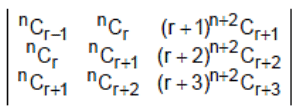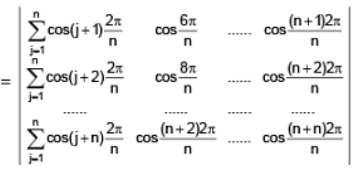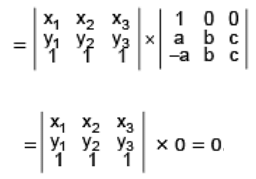Types of Determinants and Their Properties | Mathematics (Maths) Class 12 - JEE PDF Download
Determinant
(i) Submatrix : Let A be a given matrix. The matrix obtained by deleting some rows or columns of A is called a submatrix of A.

 are all submatrices of A.
are all submatrices of A.
(ii) Determinant of A Square Matrix : Let A [a]1 x 1 be a 1 x 1 matrix. Determinant A is defined as |A| = a eg. A = [–3]1 x 1 |A| = –3

then |A| is defined as ad –bc.
(iii) Minors & Cofactors : Let Δ be a determinant. Then the minor of element aij, denoted by Mij is defined as the determinant of the submatrix obtained by deleting ith row & jth column of Δ.
Cofactor of element aij, denoted by Cij is defined as Cij = (–1)i + j Mij.




(iv) Determinant : Let A = [aij]n be a square matrix (n > 1). Determinant of A is defined as the sum of products of elements of any one row (or one column) with corresponding cofactors.

|A| = a11C11 + a12C12 + a13C13 (using first row)
|A| = a12 C12 + a22C22 + a32C32 (using second column)

Properties of Determinants
P- 1 : The value of a determinant remains unaltered , if the rows & columns are interchanged . e.g. If

are transpose of each other.
If D' = - D then it is a SKEW SYMMETRIC determinant but D' = D ⇒ 2 D = 0 ⇒ D = 0 ⇒ Skew symmetric determinant of third order has the value zero .
P-2 : If any two rows (or columns) of a determinant are interchanged , the value of determinant is changed in sign only . e.g.

P-4 : If all the elements of any row (or column) are multiplied by the same number then the determinant is multiplied by that number.
P-5 : If each element of any row (or column) can be expressed as a sum of two terms then the determinant can be expressed as the sum of two determinants.

P-6 : The value of a determinant is not altered by adding to the elements of any row (or column) the same multiples of the corresponding elements of any other row (or column).
Note that while applying this property at least one row (or column) must remain unchanged.
P- 7 : If by putting x = a the value of a determinant vanishes then (x-a) is a factor of the determinant
Example: Find the value of the determinant

Sol.


Example: A is a n × n matrix (n > 2) [aij] where 
Find determinant A.
Sol.



⇒ value of determinant is zero.
Multiplication of Two Determinants
(i)
Similarly two determinants of order three are multiplied.
(ii)
where Ai , Bi , Ci are cofactors
PROOF : Consider

Note : a1A2 + b1B2 + c1C2 = 0 etc.
therefore


Example: Prove that

= (a – b) (a – c) (a – d) (b – c) (b – d) (c – d)
Sol.
Applying R2 → R2- R1, R3 → R3 - R1, we get



= (a – b) (c – d) (a – c) (b – d) [(a + c) (b + d) – (a + b) (c + d)]
= (a – b) (c – d) (a – c) (b – d) (ab +cd – ac – bd) = (a – b) (a – c) (a – d) (b – c) (b – d) (c – d).
Alternatively :

and using c3 → c3 + 2 a b c d . c3

Example: Show that

(where r2 = x2 + y2 + z2 & u2 = x y + y z + z x)
Sol. Consider the determinant:

We see that the L.H.S. determinant has its constituents
which are the co-factor of Δ. Hence L.H.S. determinant


Example: Without expanding, as for as possible, prove that

= (x – y) (y – z) (z – x) (x + y + z)
Sol.
for x = y, D = 0 (since C1 and C2 are identical)
Hence (x – y) is a factor of D, (y – z) and (z – x) are factors of D. But D is a homogeneous expression of the 4th degree is x, y, z.
∴ There must be one more factor of the 1st degree in x, y, z say k (x + y + z) where k is a constant.
Let D = k (x – y) (y – z) (z – x) (x + y + z),Putting x = 0, y = 1, z = 2, then:

= k (0 – 1) (1 – 2) (2 – 0) (0 + 1 + 2)
⇒ L(8 – 2) = k(–1) (–1) (2) (3) ∴ k = 1 ∴ D = (x - y) (y - z) (z - x) (x + y + z)
Example: Prove that

Sol.
Given that Δ =


Example: Express

as product of two determinants.
Sol. The given determinant is

with the help of row–by–row multiplication rule.
Example:

Express the determinant D as a product of two determinants. Hence or otherwise show that D = 0.
Sol.

as can be seen by applying row–by–row multiplication rule., Hence D = 0.
|
203 videos|307 docs|139 tests
|
FAQs on Types of Determinants and Their Properties - Mathematics (Maths) Class 12 - JEE
| 1. What are the different types of determinants? |  |
| 2. What are the properties of determinants? |  |
| 3. How do determinants help in solving systems of linear equations? |  |
| 4. Can determinants be negative? |  |
| 5. What is the significance of determinant value being zero? |  |


















